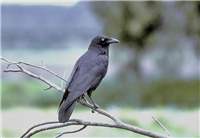Family
Corvidae
Genus
Corvus
Species
mellori
Threats/Control Methods - Regional
Shooting is a control method in some agricultural regions to combat the Little Raven's appetite for grains. Noise emitting devices may also be effective in the short term. Their natural woodland habitat in this region is considered an Endangered Ecological Community, due to its declining health.
Threats/Control Methods - Local
This species prefers to stay out of the urban environment and is limited to areas that have not been extensively cleared of woodland vegetation. Within the suburbs, their scavenging nature makes them susceptible to injury on rubbish around parks and rubbish tips.
Local/Urban Actions
Residents can limit the availability of unnatural food sources by carefully securing all garbage and food scraps and by avoiding any unnecessary irrigation of lawns and gardens. It is also helpful to cover compost heaps and removed any fruit falling to the ground around fruit trees.
Common Names
Little Raven
Distinguishing Features
This bird is only slightly smaller than the Australian Raven (Corvus coronoides ) at 48-50cm. It is a black bird with a glossy sheen. It has a bright white eye and very small throat feathers (shackles), only noticeable when calling. Young birds have brown and then hazel eyes.
Survey Techniques
Visual identification required confirmation by the Little Raven's distinct call.
Species Call
Deep baritone quick notes or abrupt 'ok-ok-ok' to fading 'ok-orhk-orrh' calls.
Similar Species
This species is almost identical to the Australian Raven (Corvus coronoides ). However, the Little Raven is lacking the long shaggy throat shackles and in flight its wings are more slender.
Distribution
This Raven is only found in the southeast of the Australian mainland, in highest numbers around Adelaide and in Melbourne and western VIC.
Country of Origin
Australia
Conservation (Pet/Pest) Status - Regional
The bird is fairly uncommon in Canberra and tends to stay in the outer fringes and ranges.
Conservation (Pet/Pest) Status - National
Secure, not listed under the EPBC Act 1999.
LSCCES Population
A few birds were found at CSIRO, ANBG, BMP and ANU.
Associated vegetation community
This species survives well in open plains or in alpine woodlands.
Limiting Resources
The Little Raven requires plentiful food and water supplies and will travel to more productive habitat areas.
Breeding
This species breeds later in the year than other Ravens and the season typically runs from April to December. Both the male and female partners build a bulky nest of sticks in fairly small trees. The female incubates 4-5 fairly large white eggs with light brown spots for 19-20 days. Both partners feed the young for the following weeks.
Behaviour
The Little Raven is distinct in its tendency to gather in tight flocks of several hundred and perform synchronised acrobatics to and from roosting sites. They are territorial birds, advertising their boundaries with short cawings and wing shuffling above their backs.
Functional Group
Food Species
The Little Raven's slender bill does not allow it to eat a wide range of carrion. Instead, it will eat a variety of insects and grains in woodland areas or will scavenge around grocery stores and waste disposal areas both in the city and at landfill sites.
Predators
Due to the strong body and territorial nature of this species, it is not in threat of predation and will instead feed on the young and eggs of other bird species.
Interesting Fact
The Little Raven was only recognised as a separate species from the Australian Raven (Corvus coronoides ) in 1967.
References - (reader suitability of references, P=Primary teachers, S=Secondary students, T=Tertiary students and researchers)
Books:Morcombe, M. 2000. Field Guide to Australian Birds. Steve Parish Publishing. Archerfield. Australia P, S, T
Schodde, R. and Tideman, S. (eds) 1990. Reader's Digest Complete Book of Australian Birds (2nd Edition). Reader's Digest Services Pty Ltd. Sydney. P, S, T
Veerman, P. 2003. Canberra Birds: A report on the first 21 years of the garden bird survey. Philip Veerman and Canberra Ornithologists Group. Canberra. S, T
Internet: Canberra Ornithological Group (COG). 2004. Birds of Canberra Gardens. COG and the ACT Department of Urban Services. [online]. Available at:http://garden.canberrabirds.org.au/ P, S, T
Online Publications:ACT Government. 2004. Woodlands for Wildlife: ACT Lowland Woodland Conservation Strategy. Action Plan No. 27. Environment ACT, Canberra. [online]. Available at: http://www.environment.act.gov.au/nativeplantsandanimals/threatecspec/woodlandsstrategy S, T
Nix, H. and Cunningham, R. 2006. Birds of the Lower Sullivans Creek Catchment, Canberra ACT. Prepared for the Life in the Suburbs project using data from the Lower Sullivans Creek Catchment Ecological Survey (LSCCES). Australian National University. Canberra. [online]. Available at: http://www.lifeinthesuburbs.com.au/category.php?id=65 S, T

 Top
Top Top
Top